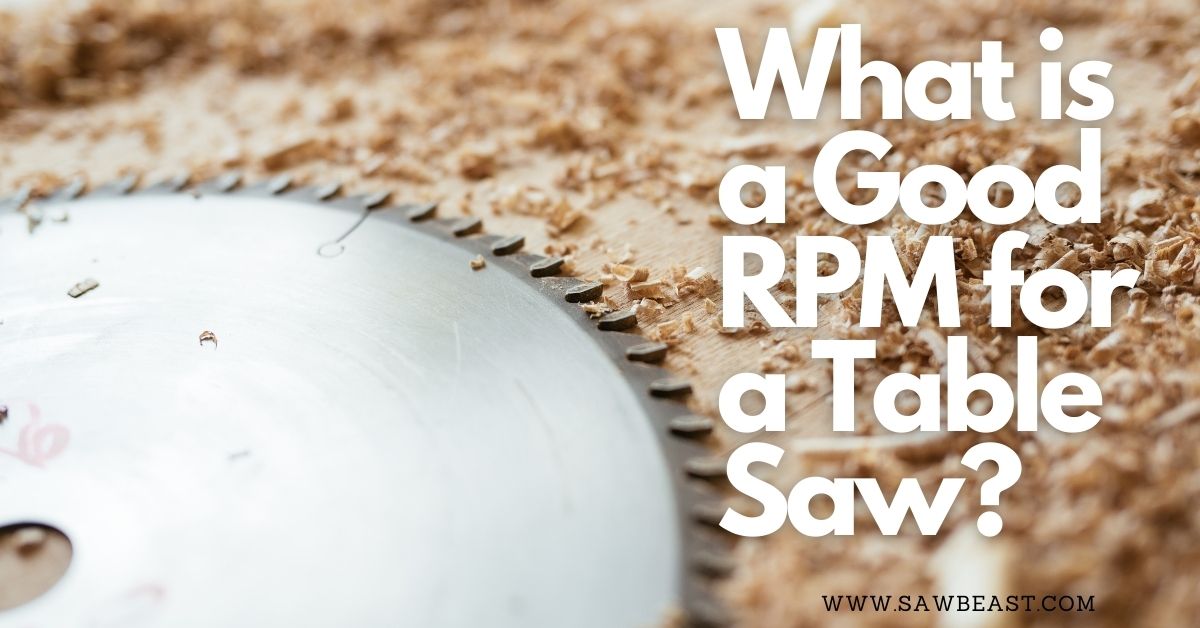The table saw rpm is often ignored and not considered when purchasing a table saw and citing reasons as to whether the table saw is an ideal choice or not. However, the RPM is just as important as other factors as it determines the speed of your saw blade as well as the efficiency with which the blade performs cuts.
Different table saws have different RPMs, depending on the size and strength of the motor which drives the saw blades. In this article, we will be discussing what is a good RPM for a table saw? is and what impact it has on the performance of your table saw.
What is the RPM of a Table Saw?
Before we actually get into our discussion about RPM, it is important to understand what it actually is. It stands for revolutions per minute and basically indicates how fast a tool spins. In the case of table saws, RPM is a measure of the speed of the shaft of the motor that drives the blade. RPM is also used to measure the blade or the arbor speed that indicates the revolutions the blade completes in one minute.
What is a Good RMP of a Table Saw?
Most table saws have a motor speed of 3,450 RPMs. This is ideal for carpentry and DIY crafts. For industrial usage, a table saw with a much higher power is preferred. Therefore, the ideal motor RPM would range between 10,000 RPM to 18,000 RPM. Most manufacturers often aim to maintain a motor speed of 15,000 RPM for commercial and industrial use.
The arbor speed is different from the motor speed. In Direct Drive Table Saws, the arbor speed is fixed like the motor speed. However, in belt-driven table saws, the arbor speed can be adjusted and you can make it higher than the motor speed. While higher speed means faster movement of the blade and more efficient cutting, it is not always beneficial and also has some disadvantages. Therefore, higher RPMs are not always ideal. The ideal RPM for your arbor and your motor is the one that suits your requirements the best.
Disadvantages of Higher RPMs
As mentioned above, faster blades and motors are not always the best choice. They can also prove to be detrimental due to loss of torque, high vibration, and damages caused by the high speed of the blades.
1. Loss of Torque
One of the major disadvantages of increasing the motor RPMs is that it lowers the torque. Torque is the force used to spin the motor and enable the table saw to operate efficiently. While you can perform cuts without the blade running at its maximum speed, the same cannot be said about the torque. In order to neatly cut through thick pieces of wood, maximum torque is required.
Most powerful motors that are used for industrial and commercial use increase their horsepower to increase the motor RPMs as well as maintain maximum torque. However, for home use, it is advised that you run your motor at a speed that does not compromise the torque force.
2. Damage to Materials
High blade or arbor speed is not good for all materials. While extremely fast blades can efficiently cut into materials like wood and glass, it is not always the case with other materials. Certain materials, like plastic, do not work well with blades moving at extremely high speed as the speed causes them to crack or melt.
In addition to this, slower blades are preferred when dealing with aluminum or thicker pieces of wood as they work better and give better results.
3. Blade Safety
Not all blades are built to withstand high speeds. Operating them at an extremely high speed can prove to be dangerous as they can break, resulting in their teeth flying off and hurting someone. Therefore, it is always advised to check the maximum RPMs for your blade on its packaging before increasing the arbor speed. For 10-inch blades, the maximum speed is around 6,500 RPMs. This is not the ideal speed, but the speed beyond which you are not advised to operate your table saw blade.
4. Burning
The more you increase the speed of your motor or your blade, the more heat is produced. Excess heat can reduce the lifespan of your blade as it will quickly get worn out. In addition to this, the blade can also leave burn marks on the material you are cutting into, ruining your workpiece. Hence, do not unnecessarily increase the arbor or motor speed.

How to Adjust the Arbor Speed of your Table Saw?
While it is impossible to adjust the motor speed, you can adjust your arbor speed. However, it is important to remember not to go beyond the maximum speed stated by the blade manufacturers.
Most table saws have a dial that allows you to easily adjust the speed. You can have complete control over the speed of your saw blade just by rotating the dial. This proves to be extremely helpful if you are dealing with different kinds of materials as you rotate the dial back and forth, depending on the material. For example, lower speeds are more suitable for plastic and aluminum while higher speeds can be used for wood.
If you have a belt-driven table saw and it is not equipped with a dial feature, you adjust the arbor speed by adjusting the motor pulley. The smaller the pulley, the higher will be the arbor speed of your table saw. However, adjusting the pulley is a tricky job. You are not advised to do this if you are a beginner because if you do not do it correctly your motor can get damaged and can even put your safety in danger.
Conclusion
It is extremely important to be aware of the optimal RPM of your table saw in order to operate it efficiently. The ideal RPM depends on the type of table saw you are using and for what purpose you are using the table saw. Most table saws work best at 3,500 RPMs to 4,000 RPMs but for industrial table saws, the RPM can go as high as 18,000 RPMs.
Most table saws provide you with the option to adjust the speed of your table saw by increasing the RPMs. However, before adjusting the speed, always confirm with the manufacturer, as faster blades are not always ideal. They can result in problems like loss of torque, and unsafe blades, and can even damage the material you are cutting into.

